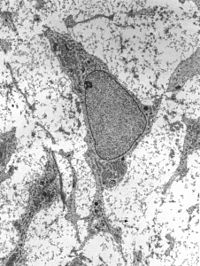
Photo from wikipedia
ABSTRACT Understanding mechanisms in lineage differentiation is critical for organ development, pathophysiology and oncogenesis. To determine whether microRNAs (miRNA) may serve as drivers or adjuncts in hepatic differentiation, we studied… Click to show full abstract
ABSTRACT Understanding mechanisms in lineage differentiation is critical for organ development, pathophysiology and oncogenesis. To determine whether microRNAs (miRNA) may serve as drivers or adjuncts in hepatic differentiation, we studied human embryonic stem cell‐derived hepatocytes and primary hepatocytes representing fetal or adult stages. Model systems were used for hepatic lineage advancement or regression under culture conditions with molecular assays. Profiles of miRNA in primary fetal and adult hepatocytes shared similarities and distinctions from pluripotent stem cells or stem cell‐derived early fetal‐like hepatocytes. During phenotypic regression in fetal or adult hepatocytes, miRNA profiles oscillated to regain stemness‐associated features that had not been extinguished in stem cell‐derived fetal‐like hepatocytes. These oscillations in stemness‐associated features were not altered in fetal‐like hepatocytes by inhibitory mimics for dominantly‐expressed miRNA, such as hsa‐miR‐99b, ‐100, ‐214 and ‐221/222. The stem cell‐derived fetal‐like hepatocytes were permissive for miRNA characterizing mature hepatocytes, including mimics for hsa‐miR‐122, ‐126, ‐192, ‐194 and ‐26b, although transfections of the latter did not advance hepatic differentiation. Examination of genome‐wide mRNA expression profiles in stem cell‐derived or primary fetal hepatocytes indicated targets of highly abundant miRNA regulated general processes, e.g., cell survival, growth and proliferation, functional maintenance, etc., without directing cell differentiation. Among upstream regulators of gene networks in stem cell‐derived hepatocytes included HNF4A, SNAI1, and others, which affect transcriptional circuits directing lineage development or maintenance. Therefore, miRNA expression oscillated in response to microenvironmental conditions, whereas lineage‐specific transcriptional regulators, such as HNF4A, were necessary for directing hepatic differentiation. This knowledge will be helpful for understanding the contribution of stem cells in pathophysiological states and oncogenesis, as well as for applications of stem cell‐derived hepatocytes. HIGHLIGHTSThe role of microRNAs in differentiation of stem cells is not well understood.This study found microRNA levels oscillated during differentiation of hepatocytes.Many functions but not differentiation were regulated by microRNAs in hepatocytes.Regulators of gene networks independently maintained hepatic differentiation.These insights will advance how stem cells may contribute in disease mechanisms and therapies.
Journal Title: Experimental Cell Research
Year Published: 2018
Link to full text (if available)
Share on Social Media: Sign Up to like & get
recommendations!